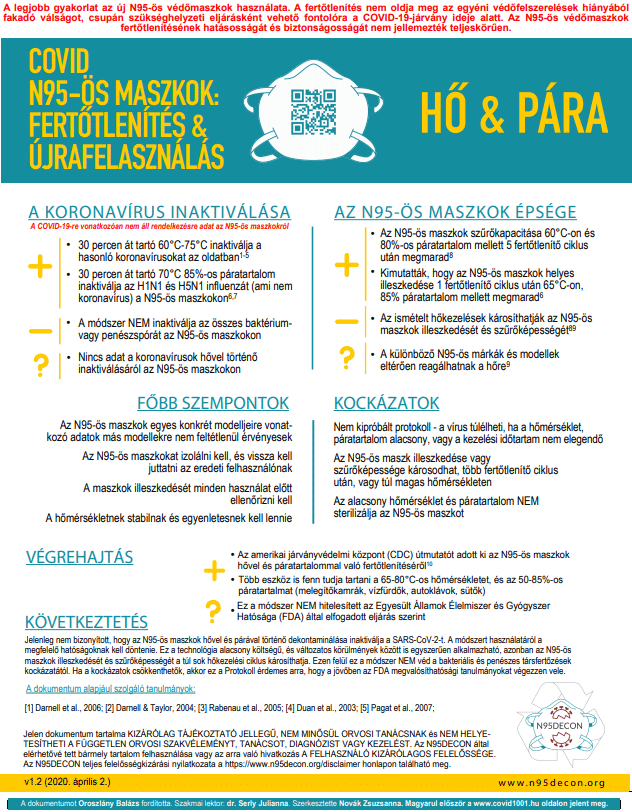Eredeti cikk dátuma: 2020. április 1.
Eredeti cikk címe: Decontamination of N95 masks
Eredeti cikk szerzői: https://www.n95decon.org/team
Eredeti cikk elérhetősége: https://www.n95decon.org/publications
Eredeti cikk státusza:
Fordító(k): Martin Anna, Oroszlány Balázs
Lektor(ok): dr. Serly Julianna
Nyelvi lektor(ok):
Szerkesztő(k): Novák Zsuzsanna
Figyelem! Az oldalon megjelenő cikkek esetenként politikai jellegű megnyilvánulásokat is tartalmazhatnak. Ezek nem tekinthetők a fordítócsoport politikai állásfoglalásának, kizárólag az eredeti cikk írójának véleményét tükrözik. Fordítócsoportunk szigorúan politikamentes, a cikkekben esetlegesen fellelhető politikai tartalommal kapcsolatosan semmiféle felelősséget nem vállal, diskurzust, vitát, bizonyítást vagy cáfolatot nem tesz közzé.
Az oldalon található információk nem helyettesítik a szakemberrel történő személyes konzultációt és kivizsgálást, ezért kérjük, minden esetben forduljon szakorvoshoz!

A szakirodalom alátámasztja a párás hő, az UV-C fény és a hidrogén-peroxid gőz használatát, mint fertőtlenítő módszereket.
A legjobb gyakorlat az új N95-ös védőmaszkok használata. A fertőtlenítés nem oldja meg az egyéni védőfelszerelések hiányából fakadó válságot, csupán szükséghelyzeti eljárásként vehető fontolóra a COVID-19-járvány ideje alatt. Az N95-ös védőmaszkok fertőtlenítésének hatásosságát és biztonságosságát nem vizsgálták teljeskörűen.

Letölthető változat: https://www.covid1001.hu/wp-content/uploads/2020/04/20200411-2_200408_N95DECONHUN_cautionsheet_v1.2_final.pdf
Technikai összefoglaló -az N95-ös védőmaszkok UV-C fénnyel történő fertőtlenítésről
A védőmaszkok UV-C fénnyel történő fertőtlenítéséről ezen a linken található részletes leírás. (angol)

Letölthető változat: https://www.covid1001.hu/wp-content/uploads/2020/04/200402_N95DECON_UV_factsheet_v1HUN-nyomtat.pdf
Technikai összefoglaló – az N95-ös maszkok hidrogén-peroxid gőzzel történő fertőtlenítéséről
Az védőmaszkok hidrogén-peroxid gőzzel történő fertőtlenítéséről ezen a linken található részletes leírás. (angol)

Letölthető változat: https://www.covid1001.hu/wp-content/uploads/2020/04/200402_N95DECON_HP_factsheet_v1HUN-nyomtat.pdf
Technikai összefoglaló – az N95-ös maszkok hővel és párával történő fertőtlenítéséről
Az védőmaszkok hővel és párával történő fertőtlenítéséről ezen a linken található részletes leírás. (angol)

Letölthető változat: https://www.covid1001.hu/wp-content/uploads/2020/04/200402_N95DECON_Heat_factsheet_v1HUN-nyomtat.pdf
Irodalomjegyzék:
3M. (2020). Disinfection of Filtering Facepiece Respirators.https://multimedia.3m.com/mws/media/1816576O/disinfection-of-disposable-respirators-technical- bulletin.pdf
Bergman, M. S., Viscusi, D. J., Heimbuch, B. K., Wander, J. D., Sambol, A. R., & Shaffer, R. E. (2010). Evaluation of Multiple (3-Cycle) Decontamination Processing for Filtering Facepiece Respirators.Journal of Engineered Fibers and Fabrics, 5(4), 33–41. https://doi.org/10.1177/155892501000500405
Casanova, L. M., Jeon, S., Rutala, W. A., Weber, D. J., & Sobsey, M. D. (2010). Effects of Air Temperature and Relative Humidity on Coronavirus Survival on Surfaces. Applied and Environmental Microbiology, 76(9), 2712–2717. https://doi.org/10.1128%2FAEM.02291-09
Chin, A. W. H., Chu, J. T. S., Mahen, R. A. P., Kenrie, P. Y. H., Yen, H.-L., Chan, M. C. W., Peiris, M., & Poon, L. L. M. (2020). Stability of SARS-CoV-2 in different environmental conditions. medRxiv. Advanced online publication. https://doi.org/10.1101/2020.03.15.20036673
Darnell, M. E. R., Subbarao, K., Feinstone, S. M., & Taylor, D. R. (2004). Inactivation of the coronavirus that induces severe acute respiratory syndrome, SARS-CoV. Journal of Virological Methods, 121( 1), 85–91. https://doi.org/10.1016/j.jviromet.2004.06.006
Darnell, M. E. R., & Taylor, D. R. (2006). Evaluation of inactivation methods for severe acute respiratory syndrome coronavirus in noncellular blood product. Transfusion, 46(10), 1700–1777.https://doi.org/10.1111/j.1537-2995.2006.00976.x
Duan, S.-M., Zhao, X.-S., Wen, R.-F., Huang, J.-J., Pi, G.-H., Zhang, S.-X., Han, J., Bi, S.-L., Ruan, L., Dong, X.-P., & SARS Research Team (2003). Stability of SARS Coronavirus in Human Specimens and Environment and Its Sensitivity to Heating and UV Irradiation. Biomedical and Environmental Sciences, 16(3), 246–255. https://www.ncbi.nlm.nih.gov/pubmed/14631830
Guan, J., Chan, M., & VanderZaag, A. (2017). Inactivation of Avian Influenza Viruses on Porous and Non-porous Surfaces is Enhanced by Elevating Absolute Humidity. Transboundary and Emerging Diseases, 64( 4),1254–1261. https://doi.org/10.1111/tbed.12499
Heimbuch, B. K., Wallace, W. H., Kinney, K., Lumley, A. E., Wu, C.-Y., Woo, M.-H., & Wander, J.D. (2011). A pandemic influenza preparedness study: use of energetic methods to decontaminate
N95Decon Research Document. Not Peer Reviewed. Version 1.2, 4/2/2020.filtering facepiece respirators contaminated with H1N1 aerosols and droplets. American Journal of Infection Control, 39, e1–e9. https://www.ncbi.nlm.nih.gov/pubmed/21145624
Lore, M. B., Heimbuch, B. K., Brown, T. L., Wander, J. D., & Hinrichs, S. H. (2012). Effectiveness of Three Decontamination Treatments against Influenza Virus Applied to Filtering Facepiece Respirators,Annals of Occupational Hygiene, 56( 1), 92–101. https://doi.org/10.1093/annhyg/mer054
Lin, K., & Marr, L. C., Humidity-Dependent Decay of Viruses, but Not Bacteria, in Aerosols and Droplets Follows Disinfection Kinetics, Environmental Science & Technology, 54( 2), 1024–1032.https://doi.org/10.1021/acs.est.9b04959
Lu, R., Zhao, X., Li, J., Ni, P., Yang, B., Wu, H., Wang, W., Song, H., Huang, B., Zhu, N., Bi, Y., Ma, X., Zhan, F., Wang, L., Hu, T., Zhou, H., Hu, Z., Zhou, W., Zhao, L., … Tian, W. (2020). Genomic characterisation and epidemiology of 2019 novel coronavirus: implications for virus origins and receptor binding, Lancet, 395( 10224), 565–574. https://doi.org/10.1016/S0140-6736(20)30251-8
McDevitt, J., Rudnick, S., First, M., & Spengler J. (2010). Role of Absolute Humidity in the Inactivation of Influenza Viruses on Stainless Steel Surfaces at Elevated Temperatures. Applied and Environmental Microbiology, 76(12), 3943–3947. https://doi.org/10.1128/AEM.02674-09
Pagat, A.-M., Seux-Goepfert, R., Lutsch, C., Lecouturier, V., Saluzzo, J. F., & Kusters, I. C. (2007). Evaluation of SARS-Coronavirus Decontamination Procedures, Applied Biosafety, 12(2),100–108.https://doi.org/10.1177/153567600701200206
Price, A., & Chu, L. (2020). Addressing COVID-19 Face Mask Shortages [v1.3]. Stanford Anesthesia Informatics and Media Lab & Learnly COVID-19 Evidence Service.https://stanfordmedicine.app.box.com/v/covid19-PPE-1-2
Prussin, A. J., II, Schwake, D. O., Lin, K., Gallagher, D. L., Buttling, L., & Marr, L. C. (2018). Survival of the Enveloped Virus Phi6 in Droplets as a Function of Relative Humidity, Absolute Humidity, and Temperature. Applied and Environmental Microbiology, 84(12), Article e00551-18.https://doi.org/10.1128/AEM.00551-18
Rabenau, H. F., Cinatl, J., Morgenstern, B., Bauer, G., Preiser, W., & Doerr, H. W. (2005). Stability and inactivation of SARS coronavirus. Medical Microbiology and Immunology, 194, 1–6.https://doi.org/10.1007/s00430-004-0219-0
van Doremalen, N., Morris, D. H., Holbrook, M. G., Gamble, A., Williamson, B. N., Tarmin, A., Harcourt, J. L., Thornburg, N. J., Gerber, S. I., Lloyd-Smith, J. O., de Wit, E., & Munster, V. J. (2020, March 17). Aerosol and Surface Stability of SARS-CoV-2 as Compared with SARS-CoV-1 [Letter to the editor].New England Journal of Medicine, 1–3. https://doi.org/10.1056/NEJMc2004973
Viscusi, D. J., King, W. P., & Shaffer, R. E. (2007). Effect of Decontamination on the Filtration Efficiency of Two Filtering Facepiece Respirator Models. Journal of the International Society for Respiratory Protection, 24, 93–107.https://www.isrp.com/the-isrp-journal/journal-public-abstracts/1138-vol-24-no-3-and-no-4-2007-pp -93-107-viscusi-open-access/file
Viscusi, D. J., Bergman, M. S., Eimer, B. C., & Shaffer, R. E. (2009). Evaluation of Five Decontamination Methods for Filtering Facepiece Respirators. Annals of Occupational Hygiene, 53(8), 815–827.https://doi.org/10.1093/annhyg/mep070
